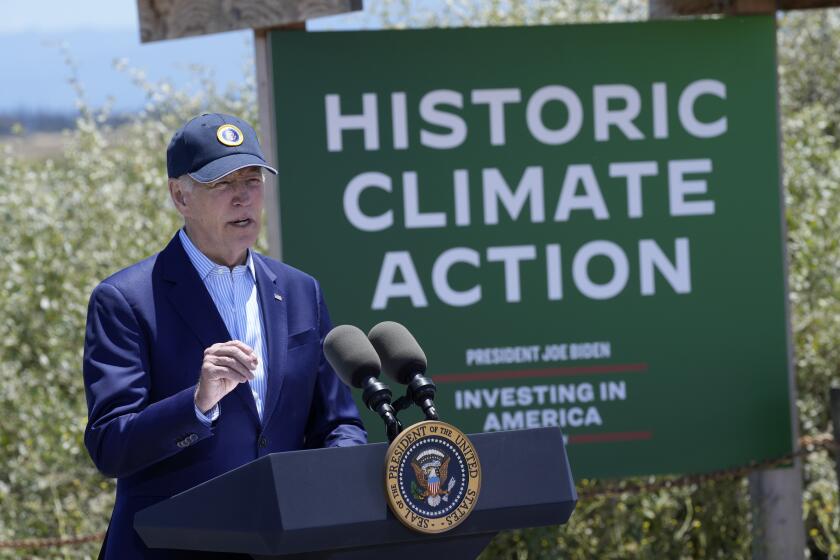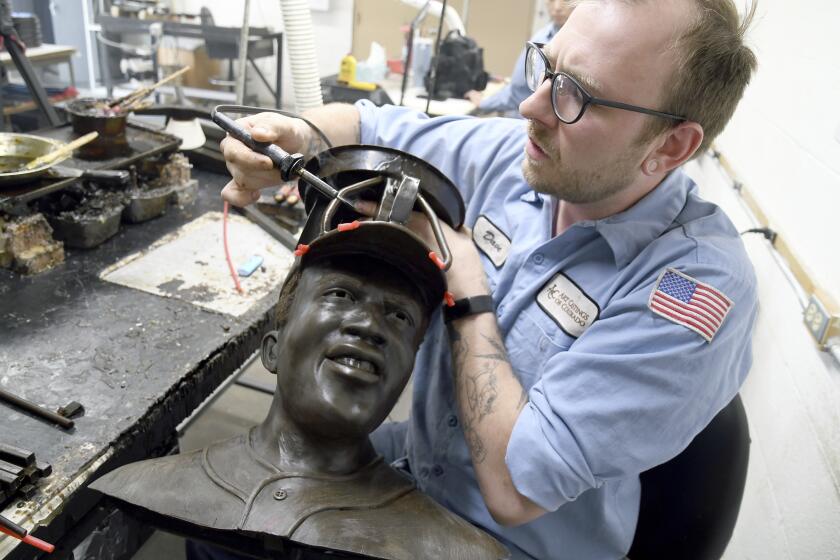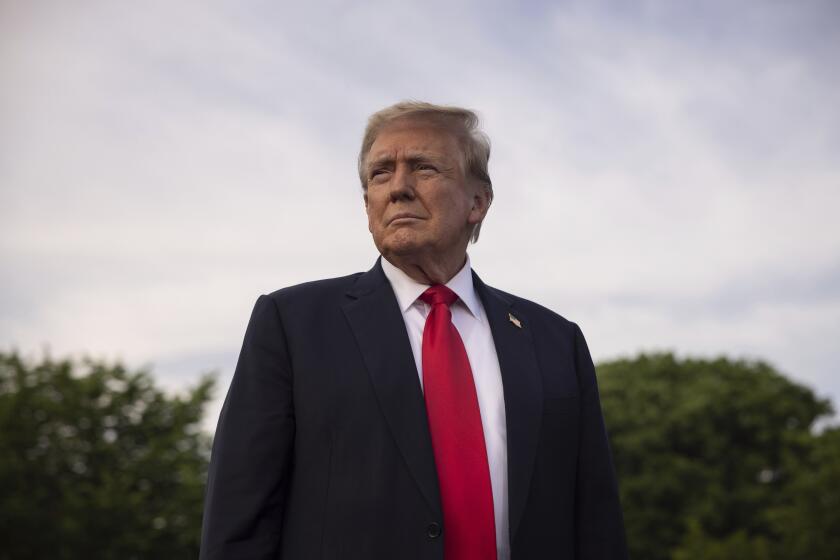Democracy by U.S. Push --and Shove
When President Reagan speaks of spreading U.S.-style democracy around the world--as he often does--Marxist regimes are clearly what he has in mind. He not only proposed a peaceful “crusade for freedom” in 1982 but has also supported anti-communist insurgencies in Nicaragua, Afghanistan and Angola.
After nearly seven years in office, however, Reagan can name only one nation where communism gave way to democracy on his watch--the tiny island of Grenada, after U.S. paratroopers and Marines used overwhelming military force to depose the leftist government.
But while the high-profile campaign to roll back communism languishes, the Administration can point to some remarkable successes for a quiet and low-visibility strategy of persuading pro-American dictators to give way to democracy.
When South Korea’s authoritarian President Chun Doo Hwan agreed in July to allow his successor to be chosen by a direct popular election, he was responding primarily to domestic factors. But U.S. officials believe that steady American pressure to open the political process may have convinced Chun that he could not successfully resist popular demand for change.
As in Haiti and the Philippines last year, the Administration carefully avoided harsh public criticism of the South Korean government while delivering an unmistakable private message.
While there are few similarities among Haiti, the Philippines and South Korea beyond the fact that they were ruled by authoritarian regimes, the general U.S. strategy was the same in all three situations. Washington supported the existing government until it began to waver in the face of growing domestic opposition, then weighed in on the side of the opposition.
When Reagan took office, he subscribed to a theory advanced by Prof. Jeane J. Kirkpatrick, later the U.S. ambassador to the United Nations, that right-wing authoritarian governments were preferable to communist totalitarian regimes--both for the people of those nations and for U.S. foreign policy.
Reagan clearly maintained that distinction when he proposed in a speech to the British Parliament in 1982 that the West join in promoting democracy throughout the world to “leave Marxism-Leninism on the ash heap of history.”
Only recently has the Administration broadened its democracy message to include nations with right-wing, autocratic governments. In Haiti and the Philippines, right-wing dictators fell to forces that promised democracy, and in South Korea a rightist regime now pledges major democratic reforms.
Robert G. Neumann, a senior adviser at the Center for Strategic and International Studies and a former U.S. ambassador, said: “I think the Reagan Administration has very lately discovered that just being anti-communist isn’t enough.”
U.S. officials say that authoritarian governments of either political extreme can be toppled only if there is a recognized local opposition strong enough to seize power on its own. But, they add, American intervention can make the transition more stable and less bloody. And, if all goes according to plan, the resulting regime is less likely to be anti-American.
Secretary of State George P. Shultz describes U.S. influence as limited but often important. “You’ve got to help them (local opposition leaders) pull the answers out of their own environment,” Shultz said recently. “We can’t snap our fingers and have people do whatever we think . . . . We try to be there and give counsel, to use our influence to see that these transitions take place in a peaceful and orderly way and in a way that is as consistent as possible with democratic principles.
“We’ve had a few cases where it didn’t work,” he said. “It didn’t work in Nicaragua; it didn’t work in Iran. We pay a heavy penalty when it doesn’t work.”
Even the last three successful results could still go sour: In South Korea, the government has pledged a democratic election, but only time will tell if that promise will be kept. In Haiti, protests have broken out against the transition regime that followed the ouster of dictator Jean-Claude Duvalier. In the Philippines, the democratic government of President Corazon Aquino has had to fight off a series of attempted military coups. Moreover, a determined communist insurgency menaces the Aquino government, just as it did the authoritarian regime of deposed President Ferdinand E. Marcos.
Some non-government experts argue that the Administration was lucky rather than skillful in all three countries.
“In the end, the Administration played a positive role in the Philippines,” said Piero Gleijeses, a professor at Johns Hopkins University’s School of Advanced International Studies. But he contended that “it was forced to play a positive role” by people like Sen. Richard G. Lugar (R-Ind.), who was Senate Foreign Relations Committee chairman through last year.
“I don’t think there is a strategy,” Gleijeses added. “It was a very ad hoc response . . . . Eventually, they contained the damage that would have come from the previous strategy.”
Neumann said the key question is how the Administration can encourage authoritarian governments to move aside without creating chaos. “I foresee that in some of those places it will go wrong,” he said. “It is impossible to fine tune. But, so far, in a number of places, the Administration has made the switch in time.”
The textbook example was in the Philippines. For the first four years of his presidency, Reagan’s relationship with Marcos was extremely close. About a year before Marcos fell, the U.S. government began warning him that he would have to move toward democracy or risk losing everything. Meanwhile, Washington continued to express support for Marcos as the recognized leader of his country.
After Marcos proclaimed himself the winner of a discredited election on Feb. 7, 1986, however, the United States shifted sides abruptly. Sen. Paul Laxalt (R-Nev.), one of Reagan’s closest friends, dramatically urged Marcos to “cut and cut quickly.” A U.S. Air Force plane was provided to whisk Marcos to exile in Hawaii less than three weeks after the election.
U.S. officials say Aquino’s “people power” revolution would probably have prevailed even without American help. But, by throwing its weight to the opposition, the United States convinced Marcos to give up without what could have been a bloody fight.
The Administration’s relations with Chun were once at least as warm as relations with Marcos. Over the last year or so, however, U.S. officials have urged Chun to permit his successor to be chosen in a truly free election. The State Department’s top Asia expert, Assistant Secretary Gaston J. Sigur, traveled to Seoul just before Chun announced that he was ready to allow open elections and other major reforms.
U.S. relations with Duvalier were never as warm as relations with Marcos and Chun. Yet the United States took no action against the Haitian dictator until his regime began to crumble. Then Washington stepped in, advising that he could no longer hold out and offering transport to exile.
Despite its successes, the Administration strategy contains inherent dangers. If a pro-American dictator realizes that the U.S. government is waiting for an opportunity to pull the rug out from under him, he might try to distance himself from Washington. In addition, the United States runs the risk of alienating opposition groups because of prior ties to authoritarian governments.
Washington managed to sidestep some of the potential anti-American backlash in the Philippines. In South Korea, however, student protests against Chun had an anti-American strain. If radical students supersede the older and more moderate political leaders of the opposition, the situation could become a major problem for U.S. policy-makers.
And, from a purely domestic political standpoint, the Administration always runs the risk of having to answer questions about who “lost” if a friendly autocrat was ultimately replaced by an anti-American regime.
More to Read
Start your day right
Sign up for Essential California for news, features and recommendations from the L.A. Times and beyond in your inbox six days a week.
You may occasionally receive promotional content from the Los Angeles Times.






